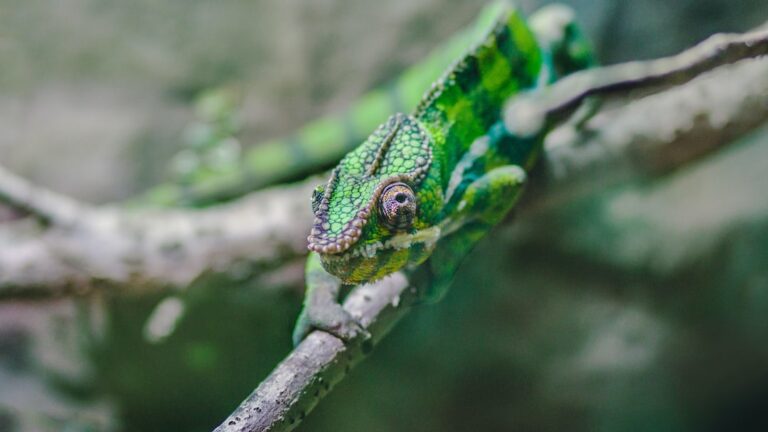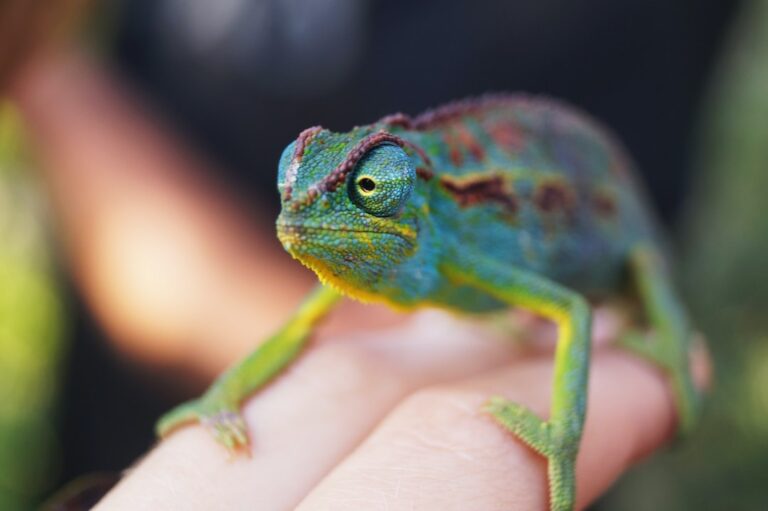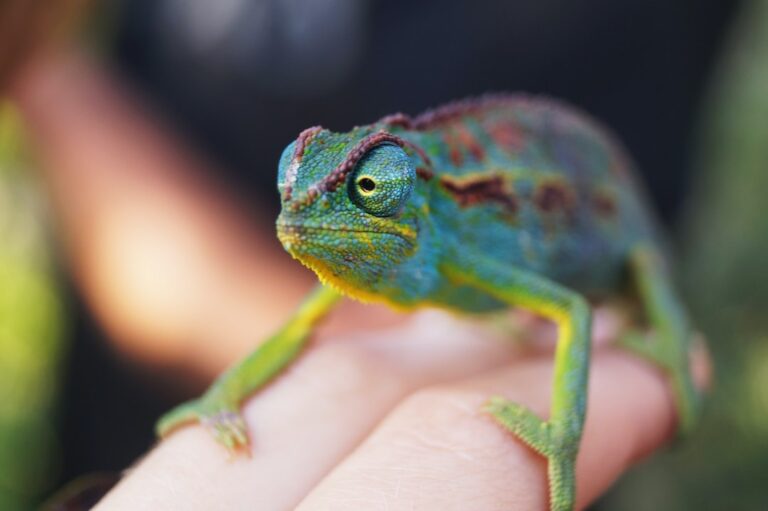Can Chameleons Climb Walls?
Chameleons are fascinating creatures known for their unique ability to change color and blend into their surroundings. They belong to the family Chamaeleonidae and are native to Africa, Madagascar, and parts of southern Europe and Asia. Chameleons have a distinctive appearance with their bulging eyes, long tongues, and prehensile tails. They are also known for their climbing abilities, which allow them to navigate through their natural habitats with ease.
One of the most remarkable aspects of chameleons is their climbing prowess. They are well-adapted to life in the trees and spend the majority of their time in the canopy. Their bodies are designed for climbing, with specialized features that enable them to move effortlessly through their environment.
Table of Contents
The Anatomy of a Chameleon
To understand how chameleons are able to climb, it is important to examine their anatomy. Chameleons have a unique body structure that sets them apart from other reptiles. They have long, slender bodies with flexible ribs that allow them to maneuver through narrow spaces. Their limbs are adapted for gripping branches, with five toes on each foot that can be used independently.
Chameleons also have specialized feet that aid in climbing. Their toes are equipped with sharp claws that provide traction on rough surfaces. Additionally, the toes on their front feet are fused together in a pincer-like arrangement, allowing them to grasp onto branches securely.
Chameleons and Their Climbing Abilities
Chameleons are highly skilled climbers and can navigate both horizontally and vertically with ease. They use a combination of muscular strength, agility, and specialized adaptations to move through their environment.
When climbing horizontally, chameleons use their powerful limbs and gripping feet to propel themselves forward. They can move quickly and gracefully along branches, using their tails for balance and stability. Their long, flexible bodies allow them to navigate through tight spaces and reach out for food or shelter.
When climbing vertically, chameleons rely on their tails and feet to anchor themselves to the surface. They use their tails as a fifth limb, wrapping it around branches or other structures for support. Their feet grip onto the surface, providing stability as they ascend or descend.
Do Chameleons Have Suction Cups on Their Feet?
There is a common misconception that chameleons have suction cups on their feet that allow them to climb. However, this is not true. Chameleons do not have suction cups or adhesive pads like some other animals, such as geckos.
Instead, chameleons rely on friction and grip to climb. The sharp claws on their toes dig into the surface, providing traction. They can adjust the angle of their toes to maximize contact with the surface and increase their grip.
How Do Chameleons Climb Smooth Surfaces?
While chameleons are adept climbers on rough surfaces, they can also navigate smooth surfaces with relative ease. This is due to their ability to generate friction and grip.
Chameleons have specialized scales on their feet that help them maintain traction on smooth surfaces. These scales have tiny ridges and grooves that increase the surface area in contact with the surface, enhancing grip. Additionally, the scales secrete a sticky substance that further aids in adhesion.
When climbing smooth surfaces, chameleons use a combination of gripping and peeling motions. They press their feet against the surface, creating friction and allowing them to cling onto the surface. As they move, they peel their feet off one at a time, ensuring a secure grip at all times.
The Role of Tail Prehensility in Chameleon Climbing
Chameleons have prehensile tails, which means they can grasp and hold onto objects. Their tails are highly flexible and muscular, allowing them to wrap around branches and other structures for support.
The tail plays a crucial role in chameleon climbing. It acts as a fifth limb, providing balance and stability as they move through their environment. Chameleons can use their tails to anchor themselves to a branch while reaching out for food or shelter. They can also use their tails to hang upside down or navigate through dense foliage.
The tail is not only used for climbing but also for communication. Chameleons can use their tails to signal their mood or intentions to other chameleons. It is a versatile appendage that serves multiple purposes in their daily lives.
Can Chameleons Climb Vertical Walls?
Chameleons are capable of climbing vertical surfaces, although it may require more effort and skill compared to climbing horizontal branches. They use a combination of their feet and tails to achieve this feat.
When climbing vertical walls, chameleons press their feet against the surface, using their sharp claws to grip onto any irregularities or protrusions. They then use their tails to anchor themselves, wrapping it around the surface for additional support.
Chameleons can also employ a technique known as “rock climbing” to navigate vertical surfaces. They alternate between pressing their feet against the surface and pushing off with their hind legs, creating a rocking motion that propels them upward.
How High Can Chameleons Climb?
Chameleons are capable of climbing to great heights in their natural habitats. The exact height they can reach depends on various factors, including the species of chameleon and the availability of suitable climbing structures.
Some species of chameleons, such as the Veiled Chameleon (Chamaeleo calyptratus), are known to climb up to 6 feet or more in the wild. They can ascend tall trees and reach the uppermost branches, where they can bask in the sunlight and find food.
Chameleons are agile climbers and can navigate through dense vegetation to reach their desired destinations. Their ability to climb to great heights allows them to access resources that may not be available at ground level, such as insects or fruits.
Factors That Affect Chameleon Climbing Abilities
While chameleons are excellent climbers, there are certain factors that can affect their climbing abilities. These include age, health, and environmental conditions.
Young chameleons may not have fully developed muscles or coordination, which can impact their climbing skills. As they grow and mature, their climbing abilities improve.
The health of a chameleon also plays a role in its climbing abilities. Illness or injury can weaken a chameleon’s muscles or impair its coordination, making climbing more challenging.
Environmental conditions, such as temperature and humidity, can also affect chameleon climbing abilities. Extreme temperatures or dry conditions may make surfaces slippery or difficult to grip onto, hindering their ability to climb effectively.
The Importance of Climbing for Chameleons in the Wild
Climbing is an essential behavior for chameleons in the wild. It serves multiple purposes and is crucial for their survival and well-being.
One of the primary reasons why climbing is important for chameleons is for finding food. Chameleons are insectivores and rely on a diet of insects and other small invertebrates. By climbing trees and vegetation, they can access a wider range of prey items that may not be available at ground level.
Climbing also provides chameleons with protection from predators. By staying high up in the trees, they can avoid potential threats on the ground. Their ability to blend into their surroundings further enhances their camouflage and helps them evade detection.
Furthermore, climbing allows chameleons to regulate their body temperature. By moving between different levels of the canopy, they can find areas that offer optimal temperature and humidity conditions. This is particularly important for thermoregulation, as chameleons are ectothermic and rely on external heat sources to regulate their body temperature.
In conclusion, chameleons are remarkable climbers with unique adaptations that allow them to navigate through their natural habitats with ease. Their ability to climb both horizontally and vertically is facilitated by their specialized anatomy, including their gripping feet and prehensile tails. While they do not have suction cups on their feet, chameleons are able to climb smooth surfaces through the use of friction and grip. Climbing is an essential behavior for chameleons in the wild, as it aids in their survival, ability to find food, and thermoregulation.
If you’re interested in learning more about chameleons, you might also enjoy reading the article “Are Chameleons Blind?” This fascinating piece explores the common misconception that chameleons are blind and delves into their unique visual abilities. Discover how chameleons use their independently rotating eyes to spot prey and predators, and gain a deeper understanding of these incredible creatures. Check out the article here.






